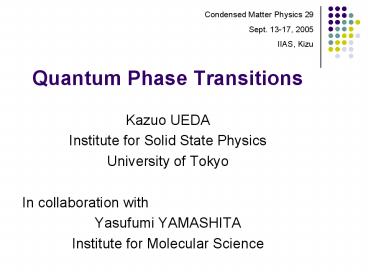Quantum Phase Transitions - PowerPoint PPT Presentation
1 / 14
Title:
Quantum Phase Transitions
Description:
Why Quantum Phase Transitions. Interesting in itself ... (ii) triangular lattice Kagom lattice. frustration. PRL 76 (1996) 3822 Fig1. pyrochlore lattice ... – PowerPoint PPT presentation
Number of Views:277
Avg rating:3.0/5.0
Title: Quantum Phase Transitions
1
Quantum Phase Transitions
Condensed Matter Physics 29 Sept. 13-17,
2005 IIAS, Kizu
- Kazuo UEDA
- Institute for Solid State Physics
- University of Tokyo
- In collaboration with
- Yasufumi YAMASHITA
- Institute for Molecular Science
2
Why Quantum Phase Transitions
- Interesting in itself
- Superconductivity in strongly correlated electron
systems - examples
- (i) high-Tc cuprates
- superconductivity close to the AF
instability - (ii) heavy Fermion superconductors
3
Phase diagram for the alloy system CeRh1-xIrxIn5
Schematic phase diagrams for hole- and
electron-doped high-Tc cuprates La2-xSrxCuO4 and
Nd2-xCexCuO4-d
4
(No Transcript)
5
Tc 52K µS 1.4µB
- discovery of co-existence of superconductivity
and ferromagnetism under high pressure
10GPa16GPa - S. S. Saxena et al., Nature 406 (2000) 587
Tsc 0.8K
N. Tateiwa et al., J. Phys. Soc. Jpn. 70 (2001)
2876
6
Routes to quantum phase transitions in magnetic
insulators
- dimer spin ladder
- plaquette CaV4O9
- depletion
- (i) 1/5 depleted square lattice CaV4O9
- (ii) triangular lattice ? Kagomé lattice
- frustration
7
pyrochlore lattice3D network of corner-sharing
tetrahedra
- Important symmetry Td
8
examples
- (1) spinel compounds (AB2O4) B-sites
- ZnV2O4 V3 (S1)
- ZnCr2O4 Cr3 (S3/2)
- (2) pyrochlore compounds (A2B2O7) A, B-sites
- Ho2Ti2O7, Dy2Ti2O7 spin ice
- (3) C15 Laves phase AMn2 Mn-sites
9
LiTi2O4 1 Ti3.5 t2g0.5 superconductivity Tc13.7K
LiV2O4 2 V3.5 t2g1.5 heavy Fermion behaviors
ZnV2O4 3 V3 t2g2 Two transitions Ts50K, TN40K
ZnCr2O4 4 Cr3 t2g3 Single transition Tc12K
1 D. C. Johnston, J. Low. Temp. Phys. 25 (1976)
145 2 S. Kondo et al., PRL 78 (1997) 1052 3
Y. Ueda et al., JPSJ 66 (1997) 778 4 S. H. Lee
et al., PRL 84 (2000) 3718
10
Lifting of degeneracy in Mott insulatorsSpin-lat
tice coupling and orbital degeneracy.
- 1 S1 Heisenberg model with spin-lattice
coupling - Y. Yamashita and K. U. PRL 85 (2000)4960
- Spin-driven Jahn-Teller distortion based on the
Valence Bond Solid picture - 2 Classical Heisenberg model with spin-lattice
coupling - O. Tchernyshyov, R. Moessner and S. L. Sondhi
- PRL 88 (2002) 067203
- 3 Spin-orbital model
- H. Tsunetsugu and Y. Motome PRB 68 (2003)
060405(R) - t2g Kugel-Khomskii model
11
Spin-driven Jahn-Teller mechanism
- ZnV2O4 spinel, S1 AF Insulator (TN40K, J53K)
- Susceptibility (Y. Ueda et al. JPSJ 66 ,778)
- Lattice structure
- Schematic energy level
- Aim of the present study
- Origin of the structural phase transition
12
AF Heisenberg model on the pyrochlore lattice
13
Magneto-elastic couplings
14
Summary The structural phase transition of AF
insulating spinel, ZnV2O4 1) S1 AF Heisenberg
model on the pyrochlore lattice is investigated
by introducing the tetrahedron-unit VBS wave
function. 2) Twofold degeneracy of tetrahedron
singlets is lifted by the spin-lattice
coupling 3)The structural phase transition can be
explained by the spin-driven Jahn-Teller
effect. (the low-temperature behaviors of
magnetic susceptibility and electronic entropy
are consistent, at least qualitatively.)































